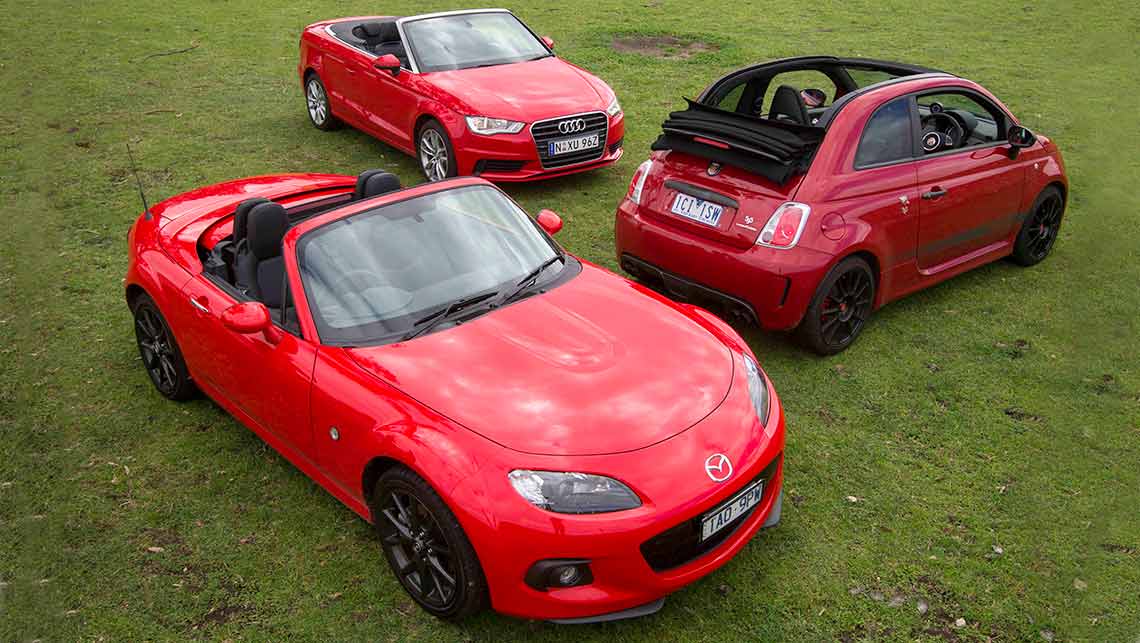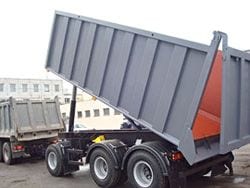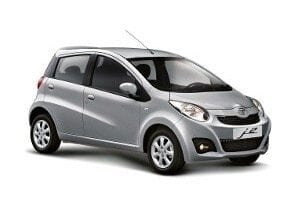
Mazda MX-5, Audi A3 Convertible and Abarth 595 Convertible 2014
It's convertible cruising season, and feeling the wind in your hair doesn't have to be too expensive.
Riding from top to bottom with a breeze in your hair is not just for the rich and famous. For as little as $21,000 a ride – the rock bottom price of a small Fiat convertible at $500 – you can enjoy a spring car.
Convertibles don't have to be fast, just cool. And they don't have to be practical, because you, and sometimes your partner, are probably the only ones who enjoy the ride. But they must be safe.
There are about 40 convertible models around. Most are in excess of $60,000, but the price peak is on the $1,075,000 Rolls-Royce Phantom Drophead.
Convertibles are among the sports cars under $100,000, a segment that is driving. Sales rose by 24% by the end of August. Expect even stronger spring and summer sales as buyers look to the sky.
SPRING SPIDERS
This trio will make you smile and won't hit your wallet too hard. Rescue vehicles Abarth 595, Mazda MX-5 and Audi A3 are also suitable for work in the city and suburbs.
VALUE
Compact dimensions, four-cylinder engines and economical fuel consumption mean low cost of ownership. But they are not in the same budget price bracket as hatchbacks.
Starting at $3, the Audi A47,300 Cabriolet needs options to bolster its upmarket aura. Satellite nav, rear camera, etc. cost $2000, and you'll have to add $450 for an acoustic roof that should be standard. That's $49,750 plus travel expenses. There's no fixed price for maintenance - Audi estimates the annual cost to be around $500.
The Abarth 595 Competizione convertible is the eighth model of Fiat's Performance division. Theoretically, this is not a Fiat, so for the car's $39,000 price tag, there's good reason to brag. Equipment levels are good, from 17-inch alloy wheels to Sabelt racing seats, a digital instrument cluster, a full-size power sunroof, and Bluetooth connectivity. Again, no service program, although Fiat/Abarth does have a service menu. The brand's exclusivity benefits a three-year resale that is valued at 61% by Glass's Guide.
Mazda MX-5 is the most popular sports car in the world and the only one that was recognized as a classic during production. There will be a new one early next year. Meanwhile, the two-seater demonstrates the simplicity and insistence on achieving excellent handling using off-the-shelf components.
But it costs $47,280 and has been on sale too many times to miss out on the features we now expect as standard - parking sensors, rearview camera, Bluetooth and so on. Mazda's limited service price includes a service fee of just $929 for three years. The secondary sale is 53 percent.
Design
This is an automotive segment dedicated to "look at me". Which one will get you the most eyes or make you the center of attention? Opinions are divided here - Abarth looks like he's on steroids and on tests has gotten the most attention. Mazda is clearly a sports car, but despite its austere beauty, it is too mundane to grab the attention of many. The Audi is perfectly built, undeniably elegant, and its visual appeal is enhanced by the German badge.
Abarth is Italian luxury with chrome finishes, multiple colors and artistic details. The digital instrument cluster is thoughtful and includes data, including side g-forces, and the slim-fitting seats are trimmed in red fabric. Unnecessarily damages the image of the Fiat "500C" badge on the dashboard on the passenger side.
The power roof is more like an extended fabric sunroof that recedes in stages, culminating in the rear window gathering and folding like a flurry over the trunk lid, masking all rear visibility. Trunk volume is 182 liters, and with the rear seats folded down, it increases to 520 liters.
Mazda has a metal convertible roof (also electric and also folding out of sight; the cloth roof model is no longer available). Interior details are sparse but perfect for a sports car theme, and all-black materials ensure there is no glare when driving. The luggage compartment is only 150 liters.
Inside, Audi wins. His salon is clinical but oozes quality. It can fit four adults, which only Abarth can match here. The trunk is surprisingly roomy - 320 liters. The fabric roof folds perfectly to fit the body so it looks stylish topless or fully clothed.
TECHNOLOGY
Abarth has crammed a small but powerful turbo engine into a tiny nose for economical use of 91 octane petrol. "Sport" mode boosts performance, while racing-focused chassis components include intuitive Koni dampers up front, ventilated discs all around and dual weight steering.
The simplest of these is the Mazda, which shares parts with previous generation passenger cars but uses a unique platform. The engine's power is relatively uninspiring, but it's relatively economical on 95 octane fuel. It has perfect weight distribution. Refined suspension components and some aluminum parts (such as the hood) keep weight down to improve performance. The six-speed gearbox is the same as the Toyota 86.
The Audi car is built on VW Group's acclaimed Golf platform and has a very smooth and quiet ride. Its turbo-four turns the seven-speed dual-clutch transmission into the best fuel economy despite being the heaviest here.
SECURITY
A four-star Mazda shows its age, while others with modern protective equipment get five points. There is a distinct sense of vulnerability that is usually associated with convertible territory.
Audi has seven airbags, front and rear parking sensors, active rollover protection, automatic wipers and headlights, and an optional safety kit. The Abarth has rear parking sensors (but desperately needs a camera), tire pressure alerts, bi-xenon headlights and five airbags. Only Mazda doesn't have a spare tire; others have space screensavers.
DRIVING
Noise - and a lot of it - is Abarth's hallmark. With the engine and exhaust in "sport" mode, it sounds like it's racing in a round of the World Rally Championship.
All in all, a fun ride, the outdoor experience is wonderful. Power pours forward, rushing through a beautifully weighted five-speed manual transmission. The steering is sharp and the seats are close to the body, although the driving position is best for smaller people.
However, when the road gets bumpy, the suspension becomes too stiff to be comfortable. The Abarth ride degenerates into a brutal jitter that throws the short-wheelbase car into corners and even blurs the driver's vision.
Far more tame is the venerable Mazda, which is best suited for driver and car to fit together like hand in hand. You can almost think about it in corners, almost move your hips to adjust the rear end, and just lightly push the steering wheel to get through the tightest corner.
Ride comfort and handling are perfectly balanced, and even if the engine lacks power, it's so fun and surprisingly competent around town. Lower the top and you'll feel like you're on a big skateboard.
Audi, however, takes the credit. Body rigidity and (optionally) acoustic fabric roof lining make it more sedan-like. The silky-smooth engine is incredibly economical.
From top to bottom - it can be dropped at speeds up to 50 km/h - gusts of wind are more than acceptable, and (optional) neck warmers protect from fresh morning or evening air. The automatic transmission has a little lag at low speeds, but overall it's a fine car.
VERDICT
Abarth - an angry boiled egg; Mazda is a dictionary definition roadster; Audi is a recipe for everything topless. Inexperienced owners will choose an Italian, singles will buy an MX-5, and more mature riders will choose an Audi.
WHAT IS A SPIDER?
The term "spider" (or marketing variants such as spyder) appears to be derived from the horse-drawn, light and open two-man carriage popular in the UK in the pre-car era. The carriage was known as the "speeder", but as the carriage became popular in Italy, the phonetic spelling "spider" was adopted. As horses gave way to internal combustion engines, small convertible two-seat sportsters became known as "spiders". There is also allegedly a reference to the original convertible roof frames, reminiscent of the thin legs of a spider.
LOOK AT
2014 Mazda MX-5
Mazda MX-5: 4 / 5
PricePrice: Starting at $47,280.
Warranty: 3 years/unlimited km
Limited service: from $929 for 3 years
Service Interval: 6 months/10,000 km
Resale Property : 53 percent
safety: 4 stars ANKAP
ENGINES: 2.0-liter, 4-cylinder, 118 kW / 188 Nm
Transmission: 6-speed manual; rear drive
Thirst: 8.1 l/100 km, 95 RON, 192 g/km CO2
dimensions: 4.0 m (L), 1.7 m (W), 1.3 m (H)
The weight: 1167kg
Spare: No
2014 Audi A3 Convertible
Attraction Audi A3 Cabriolet: 4.5 / 5
PricePrice: Starting at $47,300.
Warranty: 3 years/unlimited km
Limited service: No
Service Interval: 12 months/15,000 km
Resale Property : 50 percent
safety: 5 stars ANKAP
ENGINES: 1.4 liter 4-cylinder turbo engine, 103 kW/250 Nm
Transmission: 7-speed dual clutch automatic; FORWARD
Thirst: 4.9 l/100 km, 95 RON, 114 g/km CO2
dimensions: 4.4 m (L), 1.8 m (W), 1.4 m (H)
The weight: 1380kg
Spare: Save space
2014 Abarth 595 Competition
Abarth 595 Competition: 3.5 / 5
PricePrice: Starting at $39,000.
Warranty: 3 years/150,000 km
Limited service: No
Resale Property : 61 percent
Service Interval: 12 months/15,000 km
safety: 5 stars ANKAP
ENGINES: 1.4 liter 4-cylinder turbo engine, 118 kW/230 Nm
Transmission: 5-speed manual; FORWARD
Thirst: 6.5 l / 100 km, 155 g / km CO2
dimensions: 3.7 m (L), 1.6 m (W), 1.5 m (H)
The weight: 1035kg
Spare: Save space

